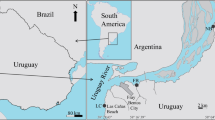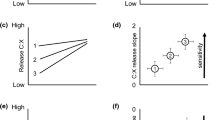Abstract
This study examined the intraspecific variability of a phenotypic trait, the body weight/body length ratio, and its adequacy to provide unbiased information about patterns of resource availability among conspecific individuals. Individual body weight and length were measured for the amphipod Gammarus minus Say (and other detritivores) in samples from freshwater springs differing in expected resource availability, and from sites in which detritus abundance had been manipulated. Mean individual weight per length was lower: (a) in populations from low-richness than from high-richness detritivore guilds; (b) in populations with size-abundance distributions similar to that of the entire guild, rather than statistically different; (c) in population samples from outside than from inside the areas of detritus addition. Small-sized individuals (< 3 mm) showed the largest variation among both populations and population samples. Similar differences were qualitatively observed for the other common detritivores co-occurring with G. minus in some springs. These observed patterns were in agreement with the variation of resource availability expected among field conditions, supporting the relevance of weight per length as a measure of food limitation.
Similar content being viewed by others
References
Anderson, N. H. & J. R. Sedell, 1979. Detritus processing by macroinvertebrates in stream ecosystems. Ann. Rev. Ent. 24: 351–377.
Andresen, H., J. P. Bakker, M. Brongersm, B. Heydemann & U. Irmler, 1990. Long-term changes of salt marsh communities by cattle grazing. Vegetatio 89: 137–148.
Basset, A., 1990. Tassi respiratori individuali in una popolazione di Gammarus pulex (L.): ruolo di mole corporea e tasso di ingestione. Rendiconti Accademia Nazionale dei Lincei 9: 203–211.
Basset, A., 1992. Aspetti funzionali dei rapporti di coesistenza tra specie in sistemi acquatici. Atti S. It. E. 15: 177–195.
Basset, A., 1993. Resource-mediated effects of stream pollution on food absorption of Asellus aquaticus (L.) populations. Oecologia 93: 315–321.
Basset, A., 1995. Body size, coexistence and guild structure: an approach to size related constraints to home-range use. Ecology 76(4): in press.
Basset, A. & L. Rossi, 1990. Competitive trophic niche modifications in three species of detritivores. Funct. Ecol. 4: 685–694.
Calow, P. & R. J. Berry (eds), 1989. Evolution, ecology & environmental stress. Biol. J. linn Soc. 37.
Dobson, M. & A. G. Hildrew, 1992. A test of resource limitation among shredding detritivores in low order streams in southern England. J. anim. Ecol. 61: 69–77.
Duncan, A., 1985. Body carbon in daphnids as an indicator of the food concentration available in the field. Arch. Hydrobiol. 21: 81–90.
Durbin, E. G. & A. G. Durbin, 1978. Length and weight relationships of Acartia clausi from Narragansett Bay, R.I., Limnol. Oceanogr. 23: 958–969.
Emlen, J. M., 1973. Ecology: an evolutionary approach. Addison-Wesley, London.
Escribano, R. & I. A. McLaren, 1992. Influence of food and temperature on lengths and weights of two marine copepods. J. exp. mar. Biol. Ecol. 159: 77–88.
Fulton, T. W., 1904. The rate of growth of fishes. Fish. Bd scot. Annual Rep. 22: 141–241.
Gee, J. H. R., 1988. Population dynamics and morphometrics of Gammarus pulex (L.): evidence of seasonal food limitation in a freshwater detritivore. Freshwat. Biol. 19: 333–343.
Glasser, J. W., 1983. Variation in niche breadth with trophic position: on the disparity between expected and observed species packing. Am. nat. 122: 542–548.
Glazier, D. S., 1991. The fauna of North American temperate cold springs: patterns and hypotheses. Freshwat. Biol. 26: 527–542.
Glazier, D. S. & J. L. Gooch, 1987. Macroinvertebrate assemblages in Pennsylvania (USA) springs. Hydrobiologia 150: 33–43.
Glazier, D. S., M. T. Horne & M. E. Lehman, 1992. Abundance, body composition and reproductive output of Gammarus minus (Crustacea: Amphipoda) in ten cold springs differing in pH and ionic content. Freshwat. Biol. 28: 149–163.
Gooch, J. L. & D. S. Glazier, 1991. Temporal and spatial patterns in mid-Appalachian springs. Mem. ent. Soc. Can. 155: 29–49.
Hutchinson, G. E., 1959. Homage to Santa Rosalia, or why are there so many kinds of animals. Am. nat. 93: 145–159.
Kankaala, P. & S. Johansson, 1986. The influence of individual viriation on length-biomass regressions in three crustacean zooplankton species. J. Plankton Res. 8: 1027–1038.
Klein Breteler, W. C. M., H. G. Fransz & S. R. Gonzales, 1982. Growth and development of four calanoid copepod species under experimental and natural conditions. Neth J. Sea Res. 16: 195–207.
Klein Breteler, W. C. M. & S. R. Gonzales, 1988. Influence of temperature and food concentration on body size, weight and lipid content of two Calanoid copepod species. Hydrobiologia 167/168 (Dev. Hydrobiol. 47): 201–210.
La Cren, E. D., 1951. The length-weight relationship and seasonal cycle in gonadal weight and condition in the perch (Perca flavescens). J. anim. Ecol. 20: 201–219.
Lomnicki, A., 1988. Population ecology of individuals. Princeton Univ. Press.
Nisbet, R. M., W. S. C. Gurney, W. W. Murdoch, & E. McCauley, 1989. Structured population models: a tool for linking effects at individual and population level. Biol. J. linn Soc. 32: 79–99.
Odum, E. P., 1985. Trends expected in stressed ecosystems. BioScience 35: 419–422.
Omori, M., 1970. Variation of length, weight, respiratory rates and chemical composition of Calanus cristatus in relation to its food and feeding. In Marine Food Chains, J. H. Steele (ed.), Univ. California Press: 113–126.
Paine, R. T., 1966. Food web complexity and species diversity. Am. nat. 100: 65–75.
Petersen, R. C. & K. W. Cummins, 1974. Leaf processing in a woodland stream. Freshwat. Biol. 4: 343–368.
Rossi, L., 1985. Interactions between invertebrates and microfungi in freshwater ecosystems. Oikas 44: 175–184.
Rossi, L., A. Basset & L. Nobile, 1983. A coadapted trophic niche in two species of Crustacea (Isopoda): Asellus aquaticus (L.) and Proasellus coxalis Dollfus. Evolution 37: 810–820.
Rossi, L., A. Basset,, L. Picciafuoco & G. Massini, 1988. Processo decompositivo ed analisi eco-funzionale nelle reti trofiche. In: Progetto lago Albano, Univ. di Roma "La Sapienza" e Provincia di Roma (eds), 10: 1–104.
Roughgarden, J., 1979. Theory of population genetics and evolutionary ecology: An introduction. Macmillan N.Y.
Tessier, A. J. & C. E. Goulden, 1982. Estimating food limitation in cladoceran populations. Limnol. Oceanogr. 27: 707–717.
Tessier, A. J., L. L. Henry, C. E. Goulden & M. W. Durand, 1983. Starvation in Daphnia: energy reserves and reproductive allocation. Limnol. Oceanogr. 28: 667–676.
Threlkeld, S. T., 1976. Starvation and the size structure of zooplankton communities. Freshwat. Biol. 6: 489–496.
Tolba, M. R. & D. M. Holdich, 1981. The effect of water quality on the size and fecundity of Asellus aquaticus. aquat. toxicol. 1: 101–112.
Author information
Authors and Affiliations
Rights and permissions
About this article
Cite this article
Basset, A., Glazier, D.S. Resource limitation and intraspecific patterns of weight x length variation among spring detritivores. Hydrobiologia 316, 127–137 (1995). https://doi.org/10.1007/BF00016894
Received:
Accepted:
Issue Date:
DOI: https://doi.org/10.1007/BF00016894




